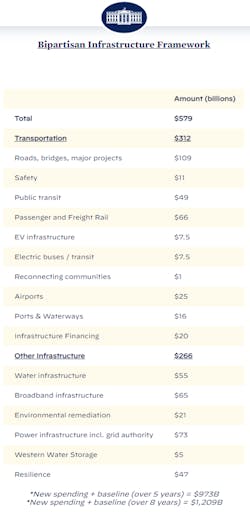Bipartisan infrastructure deal: What’s in it for trucking industry?
The chances of a new infrastructure spending bill passing increased this week after President Joe Biden and a bipartisan group of U.S. senators found some common ground. But the journey toward actual nationwide investments in roads, bridges, and other infrastructure is far from over.
“The conversations are happening because there’s a real need for infrastructure (spending) without a doubt. But this is a step in a long line of steps that need to be taken,” David Heller, VP of government affairs for Truckload Carriers Association, told FleetOwner. “It’s a supposed bill and whether it gets done or not remains anybody’s guess.”
While Biden and some senators agreed on the basic framework of $973 billion in infrastructure spending over the next five years—with another $236 billion in the subsequent three years—the administration is tying the president’s approval to other spending that Biden called “human infrastructure.”
That “human infrastructure” spending would include tax increases and money to combat climate change, support for child care, education, and other social programs that the Senate could pass through the budget reconciliation process, which would only need Democrats’ support.
The bipartisan infrastructure framework includes $312 billion in new transportation spending, $109 billion of which is for “roads, bridges, major projects.” It also provides money for public transit ($49 billion), passenger and freight rail ($66 billion), electric vehicle infrastructure ($7.5 billion), airports ($25 billion), and ports and waterways ($16 billion).
According to a White House fact sheet, the bipartisan deal would be financed through a combination of closing the tax gap, redirecting unspent COVID-19 relief funds, targeted corporate user fees, and “the macroeconomic impact of infrastructure investment.”
No Highway Trust Fund support
The White House called the deal “the single largest dedicated bridge investment since the construction of the interstate highway system.” It would also create an Infrastructure Financing Authority that would “leverage billions of dollars into clean transportation and clean energy.”
But the deal does not include an increase to the fuel tax or EV usage tax that could support the Highway Trust Fund, which Heller finds disappointing for the trucking industry. Biden didn’t want any increase in fuel taxes, which he said would hurt the middle class and low-income families.
Heller noted that the plan is “one-time dollars. It’s not a self-sustaining mechanism that the Highway Trust Fund would be with an increase of the fuel tax.”
But is any infrastructure spending better than no spending? Heller said he “wouldn’t go that far.”
“It’s not a question of is any deal better than no deal at all,” Heller said the morning after the bipartisan deal was struck. “You need the right deal. And the jury’s still out on whether something like this truly gets done. Certainly, this is one step of many that need to be taken and is tied to a whole bunch of different things out there.”
Along with the “human infrastructure” portion of Biden’s plan that he wants to be passed in tandem with this bipartisan infrastructure deal, Congress is currently working on a new surface transportation law that would replace the 2015 FAST Act that expires this fall. The new bill, which is working its way through committees in both houses of Congress, has a $303.5 billion price tag.
“There’s a confluence of large bills out there that certainly are all intermingled and all related,” Heller noted. “One will certainly affect the others.”
How does trucking benefit?
The most significant benefit for trucking from the surface transportation bill and the bipartisan infrastructure bill is improvements to roads and bridges, Heller said. “That’s the one thing we desperately need. We need a fix to our infrastructure—our physical infrastructure such as roads and bridges, which is the traditional definition of infrastructure. That’s the trucking-related thing in there. But there’s nothing in there that highlights trucking specifically in a sense—but the roads and bridges aspect is what interests us the most.”
Heller noted that during the height of the COVID-19 pandemic, as many Americans stayed home and drove less, trucking flourished with less congestion on the roads. And despite special federal waivers that would have allowed drivers more flexible hours of service rules during the pandemic, many fleets didn’t need the extra time because traffic was so light.
“If we fix our infrastructure, get better lanes, get more lanes, that congestion is reduced and we can effectively travel more efficiently on our roads today, it helps the industry effectively move freight with capacity as tight as it is today,” he said.
Recent bridge failures (a pedestrian bridge over a major thoroughfare in Washington, D.C., and the closure of an Interstate 40 bridge that crosses the Mississippi River) have shown how fragile the U.S. infrastructure is. “How much does that cost the industry because our infrastructure has crumbled?” Heller asked. “If they can fix and prevent these problems, we can effectively and productively move freight.”
About the Author
Josh Fisher
Editor-in-Chief
Editor-in-Chief Josh Fisher has been with FleetOwner since 2017. He covers everything from modern fleet management to operational efficiency, artificial intelligence, autonomous trucking, alternative fuels and powertrains, regulations, and emerging transportation technology. Based in Maryland, he writes the Lane Shift Ahead column about the changing North American transportation landscape.


